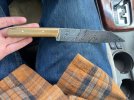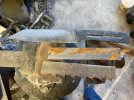Oliver Sommer
Basic Member
- Joined
- Nov 21, 2024
- Messages
- 10
For a While now I have been trying to find a "cheap" way to make Damascus. at one point I had been given a bunch of old bandsaw blades from a portable wood bandsaw mill. I then got some worn out ones from the local steel suppliers metal bandsaw. I hand forging the billets, but I always had delamination problems. Once I got my press working, I decided to give it another try, I got a solid weld and was able to forge a blade. When I tried to anneal it I realized that it was some form of air harden. I got the knife ground down and hardened it in the air and clamped in my vise. I Rockwell tested it and got 63rc in one place and 60rc in two other places. There is surprisingly good contrast for being mystery steel. I'm hoping that someone would have an idea of what steel it could be. I'm thinking that the bright steel could be L6 and the dark D2. If anyone has any experience with bandsaw Damascus or air harden steels, that would be great.



